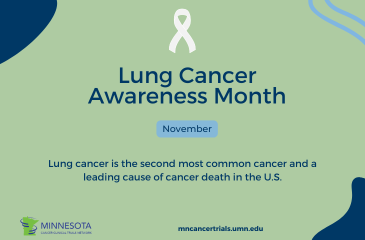Lung Cancer Awareness Month: Screening & Early Detection
About Lung Cancer
November is Lung Cancer Awareness Month. Lung cancer is the second most common cancer for men and women in the United States. It is the leading cause of cancer death, accounting for about 1 in 5 deaths from cancer. Lung cancer most commonly affects older adults, and typically it is diagnosed in people over the age of 65. Lung cancer rates vary greatly between different regions, races, and ethnicities in Minnesota. Highest lung cancer rates exist in Northern and Central Minnesota. Lung cancer disproportionately affects American Indians in Minnesota. This is largely due to increased tobacco use.
Smoking is the most common cause of lung cancer, with 80 percent of lung cancers caused by smoking. Other causes include radon exposure, secondhand smoke, and exposure to other carcinogens and pollutants in the workplace or other environments. Today, new cases of lung cancer are decreasing due to people quitting or never smoking, and so are death rates due to lower smoking rates and advances in treatment and screening.
Lung Cancer Screening
Cancer screening is crucial because it can detect certain cancers early before the cancer is advanced or spreads to other parts of the body. Screening can catch cancer before it causes any symptoms. There are screening tests for many types of cancer, including lung cancer. Lung cancer is screened for with a test called a low-dose CT (LDCT) scan. A CT scan takes pictures inside the body, and the pictures are combined by a computer to make detailed 3-dimensional images. Doctors can then see if there are tumors or other abnormalities from these images. LDCT scans are used in people who are at a higher risk for developing lung cancer, usually due to current or past history of smoking.
Lung Cancer Screening Research
Lung cancer screening was studied extensively with the National Lung Screening Trial. This was a national study that enrolled more than 53,000 participants from 2002 to 2004. Participants were older (55-74 years old) adults who were current or past heavy smokers. Participants were randomly assigned to either receive LDCT or chest radiography for three annual screenings. The study team then tracked who developed and died from lung cancer through 2009. 1,060 lung cancers were detected in the LDCT group, and 941 were diagnosed in the chest radiography group. The study found that the people who received LDCT screening had a 20 percent lower risk of dying from lung cancer compared to the chest radiography group. Ultimately, the study found that LDCT screening detects positive results and reduces the risk of lung cancer death significantly.
Lung Cancer Screening Today
Today, annual LDCT screening is recommended for people 50 to 80 years old who currently smoke or who quit in the last 15 years with a 20 pack per year history. Despite these recommendations and studies demonstrating the value of lung cancer screening, screening rates remain low. Nationally, only 5 percent of eligible people are screened for lung cancer annually. Minnesota’s screening rates are slightly higher but still very low at 8 percent. Low screening rates may be due to stigma about smoking, physicians not discussing or offering screening to eligible patients, lack of awareness or access to health care, and fear of the process or of false positive results.
MNCCTN is working to develop strategies to increase lung cancer screening rates in Minnesota through funding and collaboration with researchers on multiple lung cancer screening studies in Greater Minnesota and in Minneapolis. Learn more about these studies:
To learn if you’re eligible for lung cancer screening, check out more information about lung cancer screening and current guidelines.
